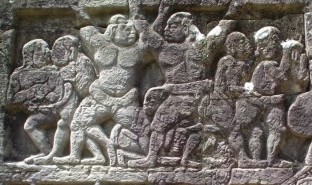|
Bas relief of wrestlers on a wall at Bayon temple. |
Sports and recreational activities are found in every culture around the world. For Cambodians, a brilliant historical record of sports and recreation during the Classical Angkor Period (9th -14th century) can be seen on the bas reliefs of the Bayon Temple complex South Gallery. The hand carved depictions of sports such as kickboxing and wrestling as well as cock and boar fighting suggest recreational activities have been a vital part of Cambodian everyday life and culture for centuries. The exact purpose and meaning of these activities to the ancient Khmer is unknown. However, we do know that many of these types of competitive and gaming activities have thrived throughout Cambodia long after the Khmer Empire.
Cambodia’s tumultuous history of warfare and colonial rule over the centuries has overshadowed the changes occurring in the country after independence from the French in 1954. To emerge as a modern and independent nation required a reconfiguring of the social, cultural, political and economic life of the people. Sports figured in the modernizing process. Cambodia invested in sports programs in schools and on military bases. In 1956, Cambodia participated in the Olympic Games and was one of the founding nations of Southeast Asian Peninsular Games (SEAP) in 1959. The two most popular national sports were soccer and kickboxing. Other sports such as tennis, volleyball and badminton were also popular. Cambodia’s venture into the sports world was short lived. The intensifying Vietnam-American War compounded by internal strife created too much instability for Cambodia. Participation in the Ollympic Games was halted by the end of the 1960s and they were unable to play a part in SEAP until 1995.
As the Khmer Rouge gained a stronghold in Cambodia in the 1970s and eventually toppled the Lon Nol government in 1975, athletes were forced to escape in fear for their lives or were killed during the reign of terror. Like teachers, artists, military, and government personnel, athletes were considered a part of the educated class and thus corrupted by Western imperialists according to the ideology espoused by the Khmer Rouge leadership. Few athletes survived this dark and deadly period.
Participation in sports and recreational activities has been a way for Cambodians in Long Beach to create social bonds and to illustrate their country’s place in the sports world. As more refugees settled in Long Beach in the 1980s, individuals and community organizations also recognized the benefit of promoting healthy living and companionship through familiar and new activities for adults and youth in the adjustment process. Although sports teams and recreational activities were formed to attract Cambodians and foster a sense of ethnic belonging, overtime it was through these activities that Cambodians mingled with other groups and shared their cultural history. |
Forthcoming in this section:
|
|

 ខ្មែរ
ខ្មែរ  English
English 